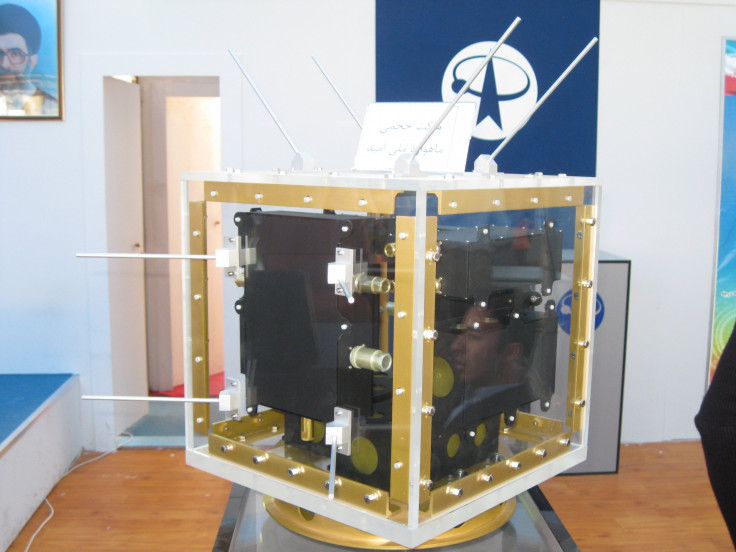Monkey Business: Iran Plans To Send Primate Into Orbit Next Month To Accelerate Space Program

Iran plans to send a live monkey into orbit next month on a satellite carrier to restart its fledgling space program.
A prior attempt to send a primate into space reportedly failed in 2011.
Hamid Fazeli, head of the Iranian Space Agency, told the Mehr News agency of Tehran that the "testing phase of these living capsules has ended and monkeys to be sent to space are now in quarantine.”
"Monkeys have similarities to humans, so by observing them in space, we can examine human factors in space," he added.
Subject to a successful test run, ISA projects it will be able to send a man into outer space in five to eight years.
Iran reportedly aspires to send an astronaut to the moon by 2025.
Fazeli also stated: "These monkeys will be sent into space according to a timetable on Fajr Ceremonies," referring to the 10-day period in early February when the Iranian Revolution of 1979 is commemorated.
That suggests the launch would have to be done by mid-February.
The primate (or primates) will be aboard a satellite called Pishgam (Pioneer).
The real pioneers of space travel, the U.S. and the Soviet Union, sent animals, including monkeys, into orbit more than 50 years ago to gauge their reactions before launching manned missions.
Iran seeks to join the space race in a hurry.
In February 2010, Iran sent its first "biocapsule" -- containing a rat, two turtles and some worms -- into space on its Kavoshgar-3 carrier.
The year before that the Islamic Republic launched its first domestically built data processing satellite, the Omid (or Hope).
But Iranian media did not explain why the aforementioned 2011 launch failed (or was canceled).
New Scientist magazine reported that Iran is the ninth country in the world to launch domestically built satellites into orbit, and the sixth nation to launch animals into space.
Iran’s nascent space program has prompted concern from some Western nations in light of its concurrent ambitions to develop nuclear power. Fox News noted that there are worries in the U.S. and Europe that Iran’s rocket program could include military applications, including the deployment of long-range ballistic missiles capable of carrying nuclear warheads.
Iran has denied that its space program, like its nuclear power projects, pose any threat to other countries. Indeed, Tehran has stated that its space ambitions are focused upon such endeavors as earthquake monitoring, imaging and improvement of telecommunications.
According to FirstPost newspaper of India, Iran was one of the 24 founding members in 1959 of the United Nations’ Committee on the Peaceful Uses of Outer Space.
Bhupendra Jasani of King's College London, who studies military applications in space, told New Scientist last year that if Iran succeeds in sending a monkey into orbit and returning it unharmed back to earth, that “would show its capability to return scientific payloads from orbit. However, to launch a human may take some time."
But Jasani warned: “Iran, like many other space-faring nations, is developing a space program not only for the sake of prestige but also for national security reasons."
Other observers believe Iran’s space program is designed to raise its profile and prestige.
"The world community hasn't tried to stop Iran's rocket program like they have North Korea's because overall Iran is doing things that demonstrate it is serious about having a space program,” said Brian Weeden, technical adviser for the Secure World Foundation, which promotes peaceful uses of outer space.
“Although North Korea says they have a space program, their actions lead many to conclude that it's really just a way to legitimize their development of ballistic missile technology. I think [for Iran] prestige is the most likely because it's the main reason why most countries pursue human space flight. You can demonstrate your country's technical and scientific prowess with robotic satellites, but those are hard to show off because they stay in space. A living, breathing organism is much easier for the public to identify with and, if you can bring it back down safely, much easier to publicize.”
Russia is believed to have assisted the Iranians in developing their space program, but apparently Moscow now has misgivings about its role in this adventure.
In February 2011, after Iran had already launched a satellite, Russian military and scientific officials reportedly expressed fears that they inadvertently provided Teheran with missile technology that could one day spawn ballistic missiles that could reach anywhere in the Mideast or even Moscow.
“A variety of Russian experts over the past few years have said Tehran intends to use space launch vehicle technology to develop intercontinental ballistic missiles systems that could reach targets throughout most of the Middle East,” said a report from the CIA that monitored Russian media and government statements.
“There is less consensus among Russian experts regarding the pace at which Iran will be able to develop intercontinental ballistic missiles.”
Moreover, Alexandr Nemets, a Russian scholar, and Robert Kurz, an analyst at the U.S. Army’s Fort Leavenworth Foreign Military Studies Office, warned in a 2009 report in the Journal of Slavic Military Studies: “Iran’s primary effort to develop its space technology sector is likely intended for military purposes. This obviously includes its development of reconnaissance and military telecom satellites, the technology to upgrade long- range missiles such as the Shahab-3 class, and the development of the more powerful Shahab-4 and Shahab-5 missiles.”
© Copyright IBTimes 2024. All rights reserved.





















